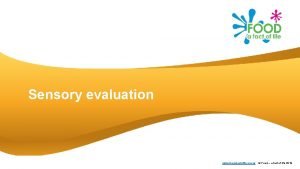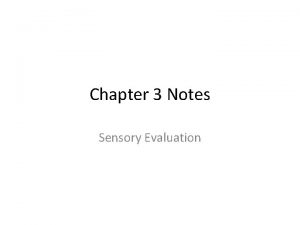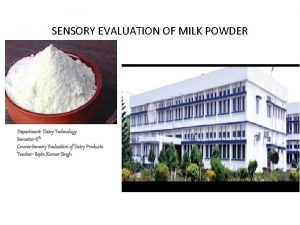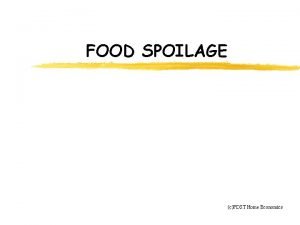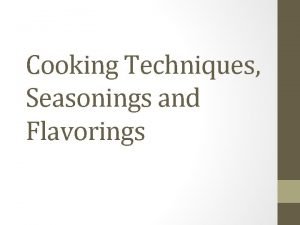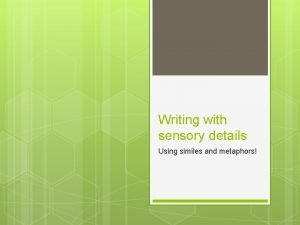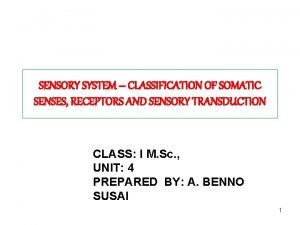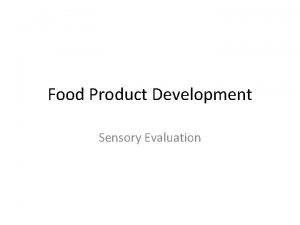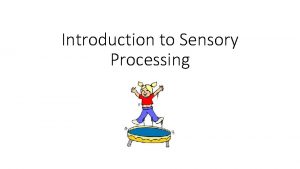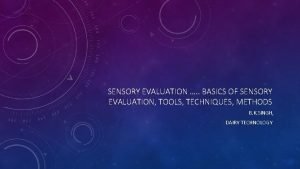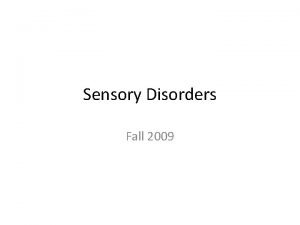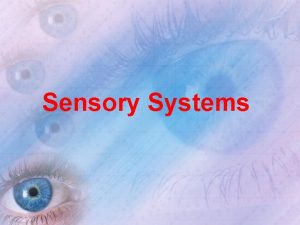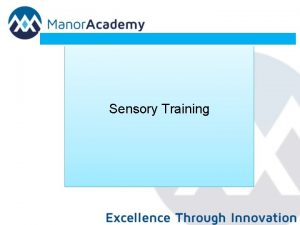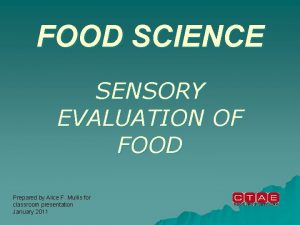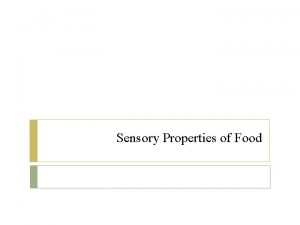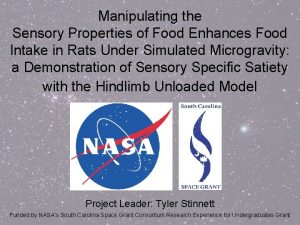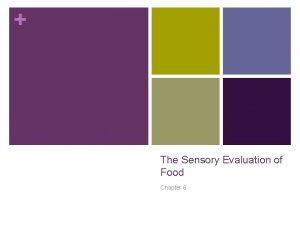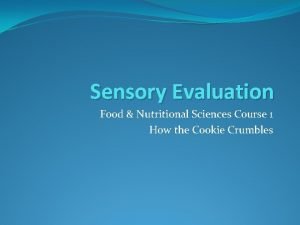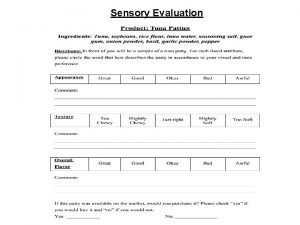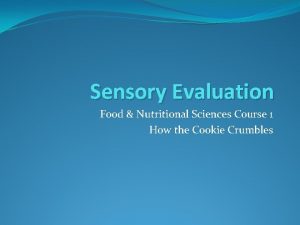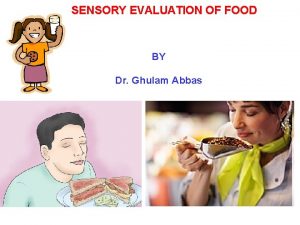INTRODUCTION TO SENSORY EVALUATION OF FOOD DR MD























- Slides: 23

INTRODUCTION TO SENSORY EVALUATION OF FOOD DR MD BELLAL HOSSAIN Head Dept. of NFE/DIU

SENSORY EVALUATION Sensory - having to do with the senses of sight, taste, smell, hearing, touch - judgment of quality based on sensory data Organoleptic - subject to judgment by the senses Senses - the means of receiving all information

THE CHEMICAL SENSES SIGHT- VISION TASTE - GUSTATION SMELL - OLFACTION

MECHANICAL SENSES TOUCH - TACTILE SENSES HEARING - SOUND KINESTHESIS - MOTION EQUILIBRIUM - BALANCE

OTHER FACTORS Social and Family Cultural Religious beliefs Nutrition and Health Economic and Marketplace factors Technological developments Emotional and psychological factors

SIGHT - VISION Creates first impression Visual appeal - attractiveness Used to judge quality - ripeness, freshness, concentration, defects, extent of cooking

VISUAL PROPERTIES OF FOOD Color Transparency or opaqueness Dullness or gloss Size Shape Amount Defects, decay, infestation

TASTE Detects water soluble chemicals Tongue - taste “buds” located in the papillae Substance must be dissolved in water or saliva Flavor – combination of taste and odor – complex mixture

FIVE TASTES Sweet - Due to alcohol (OH) groups, detected quickly, on the tip of tongue Salty-Sodium ion modified by Chloride, detected quickly, on tip of tongue Sour-Acid, due to hydrogen ions, detected on side of tongue Bitter-taste buds at back of tongue Umami-savory, glutamate that occurs naturally in food. Some examples of these foods are parmesan cheese, bacon bits, soy sauce, meat, ketchup, from flavor enhancers such as MSG

TASTE SENSITIVITY Taste is affected by other stimuli Time: Location of taste buds Threshold-Concentration required for substance identification Sub-threshold-Substance not identified, but will affect perception of another taste

EFFECT OF SUB-THRESHOLD SUBSTANCES Salt Increases sweet, decreases sour Sour Increases salty, decreases sweet Sweet Decreases salt, decreases bitter

TEMPERATURE AND TASTE Affects flavor, warm foods taste stronger and sweeter than cold foods Salt stronger in warm foods Volatility of substances increase at warm temperatures, so they smell stronger-pungency Taste buds most receptive at temperatures between 68860 F

PSYCHOLOGICAL FACTORS Flavor perceptions based on color, color intensity, texture (thickness) General health and well-being Time of day Adaptation-Previous exposure to substance, especially salt tastes (salt and resalt foods)

OLFACTORY - SMELL Ability to detect chemicals dissolved in air Aroma impacts on taste Don’t taste greasy, chocolate, mint – smell, mouthfeel, or combination

TEXTURE - TACTILE Qualities felt with fingers, tongue, palate, teeth Index of quality Smoothness, stickiness, graininess Crispness, crunch

TASTE AND AGE Varies over the lifespan Highest taste sensitivity occurs in babies Number of taste cells in humans declines with age Serious decline in taste cell numbers begins ~45 y. o. By 70 greatly lowered ability to taste

SENSORY TESTING Analytical -Laboratory evaluation, used in early stages of product development, objective evaluation Affective - Consumer evaluation to measure acceptance and preference DIFFERENCE TESTS ACCEPTANCE/PREFERENCE DESCRIPTIVE TESTS

DIFFERENCE TESTS Determine perceivable difference between products Changing ingredients or source of ingredient Check quality of product over time Check shelf life of a product Triangle test-three samples, two alike, determine the odd sample Duo-trio test- match the reference product

ACCEPTANCE/PREFERENCE Paired Preference-choose preferred item Ranking-rank preference Rating Absolute Judgment Hedonic – measures how much liked or disliked Food Action – would you eat or buy

DESCRIPTIVE TESTS Trained panelists Difference between products Highly specialized tests

ANALYTICAL EVALUATION Uses equipment Sprectrophotometer - color Consistometer - consistency Viscometer-viscosity

COMPARING SUBJECTIVE & OBJECTIVE EVALUATIONS Subjective/sensory Objective analysis Uses individuals Uses equipment Involves human sensory organs Uses physical, chemical techniques Results may be variable Results are repeatable Determines human sensitivity Need to find technique appropriate for food Determines customer acceptance Cannot determine consumer acceptance Time consuming, expensive Faster, cheaper, more efficient Essential for product development Essential for routine quality control

THANKS!
 Food a fact of life sensory analysis
Food a fact of life sensory analysis Sensory evaluation the human factor
Sensory evaluation the human factor Sensory evaluation cryptogram
Sensory evaluation cryptogram Sensory evaluation of milk and milk products
Sensory evaluation of milk and milk products Chapter 3 sensory evaluation the human factor
Chapter 3 sensory evaluation the human factor Sensory evaluation
Sensory evaluation Reasons for food spoilage
Reasons for food spoilage Sensory characteristics of food
Sensory characteristics of food Unit 2 food food food
Unit 2 food food food Grazing food chain diagram
Grazing food chain diagram Food quality evaluation
Food quality evaluation Introduction to monitoring and evaluation
Introduction to monitoring and evaluation Introduction of evaluation
Introduction of evaluation Introduction of evaluation
Introduction of evaluation The metaphor
The metaphor 11 sentence paragraph
11 sentence paragraph Concrete detail definition
Concrete detail definition Sensory ethnography
Sensory ethnography What does sensory language mean
What does sensory language mean Sensory figure of harriet tubman
Sensory figure of harriet tubman Anatomy of visual system
Anatomy of visual system Sensory language definition
Sensory language definition Structure of the sensory system
Structure of the sensory system Classification of sensory receptors
Classification of sensory receptors
